MBA643 Postgraduate Case Study: Apple Store Project Risk and Finance
VerifiedAdded on 2023/03/23
|6
|1157
|78
Case Study
AI Summary
This case study analyzes Apple's proposed temporary store in Adelaide's Victoria Square. It examines the project's financial viability, considering initial investment, revenues, costs, and salvage value. The assignment requires calculating the Net Present Value (NPV) of the project using a 12% discount rate and making an investment recommendation. It also addresses project risk management, specifically the need for risk assessment beyond NPV analysis to avoid issues faced in a previous project. Furthermore, the case study incorporates scenario analysis to evaluate the project's feasibility under different outcomes regarding the store's sale value at the end of its three-year lifespan. The student provides answers to questions related to risk assessment, NPV calculation, investment decisions, and scenario analysis, demonstrating an understanding of financial concepts and project management principles.
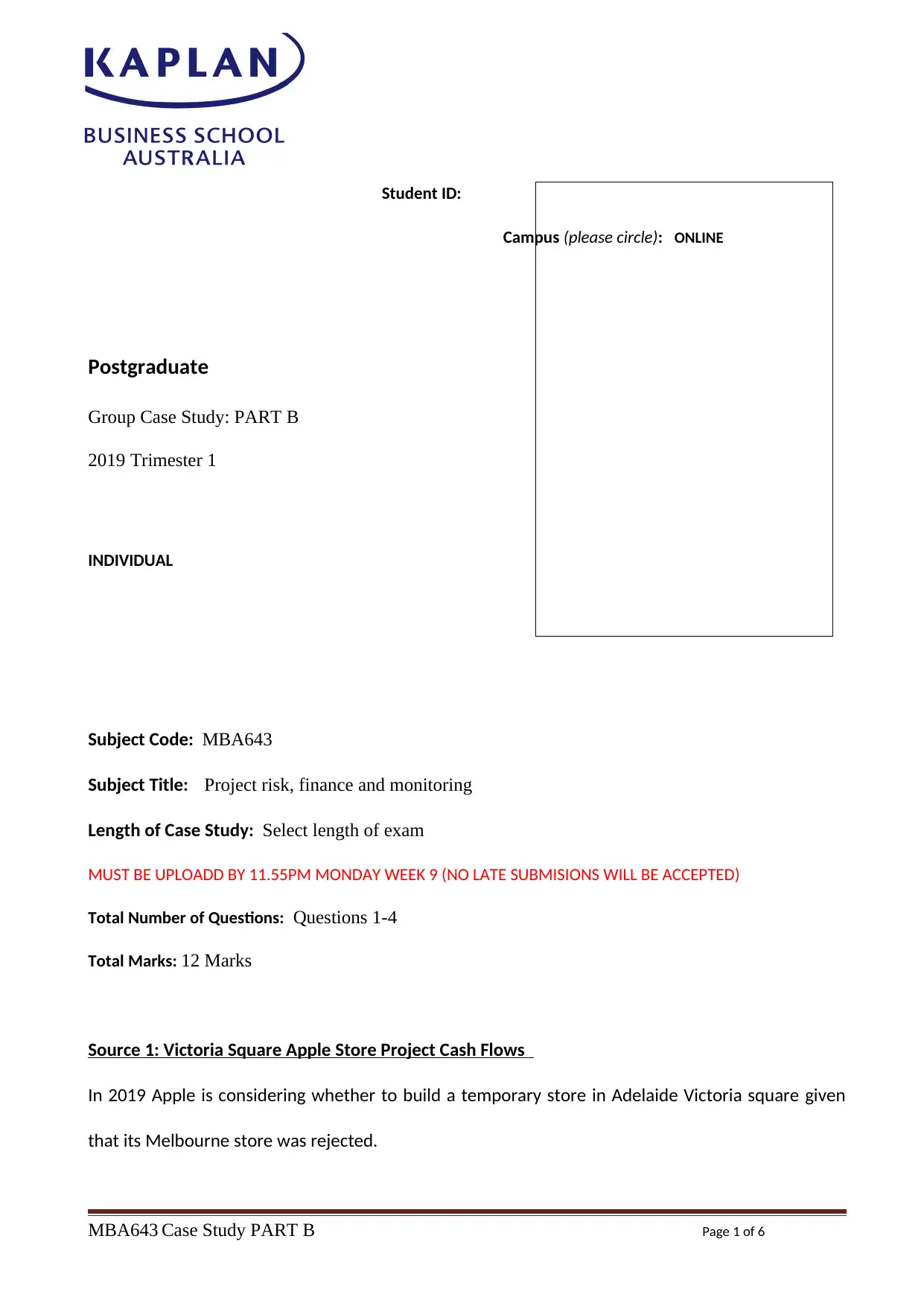
Campus (please circle): ONLINE
Postgraduate
Group Case Study: PART B
2019 Trimester 1
INDIVIDUAL
Subject Code: MBA643
Subject Title: Project risk, finance and monitoring
Length of Case Study: Select length of exam
MUST BE UPLOADD BY 11.55PM MONDAY WEEK 9 (NO LATE SUBMISIONS WILL BE ACCEPTED)
Total Number of Questions: Questions 1-4
Total Marks: 12 Marks
Source 1: Victoria Square Apple Store Project Cash Flows
In 2019 Apple is considering whether to build a temporary store in Adelaide Victoria square given
that its Melbourne store was rejected.
MBA643 Case Study PART B Page 1 of 6
Student ID:
Postgraduate
Group Case Study: PART B
2019 Trimester 1
INDIVIDUAL
Subject Code: MBA643
Subject Title: Project risk, finance and monitoring
Length of Case Study: Select length of exam
MUST BE UPLOADD BY 11.55PM MONDAY WEEK 9 (NO LATE SUBMISIONS WILL BE ACCEPTED)
Total Number of Questions: Questions 1-4
Total Marks: 12 Marks
Source 1: Victoria Square Apple Store Project Cash Flows
In 2019 Apple is considering whether to build a temporary store in Adelaide Victoria square given
that its Melbourne store was rejected.
MBA643 Case Study PART B Page 1 of 6
Student ID:
Paraphrase This Document
Need a fresh take? Get an instant paraphrase of this document with our AI Paraphraser
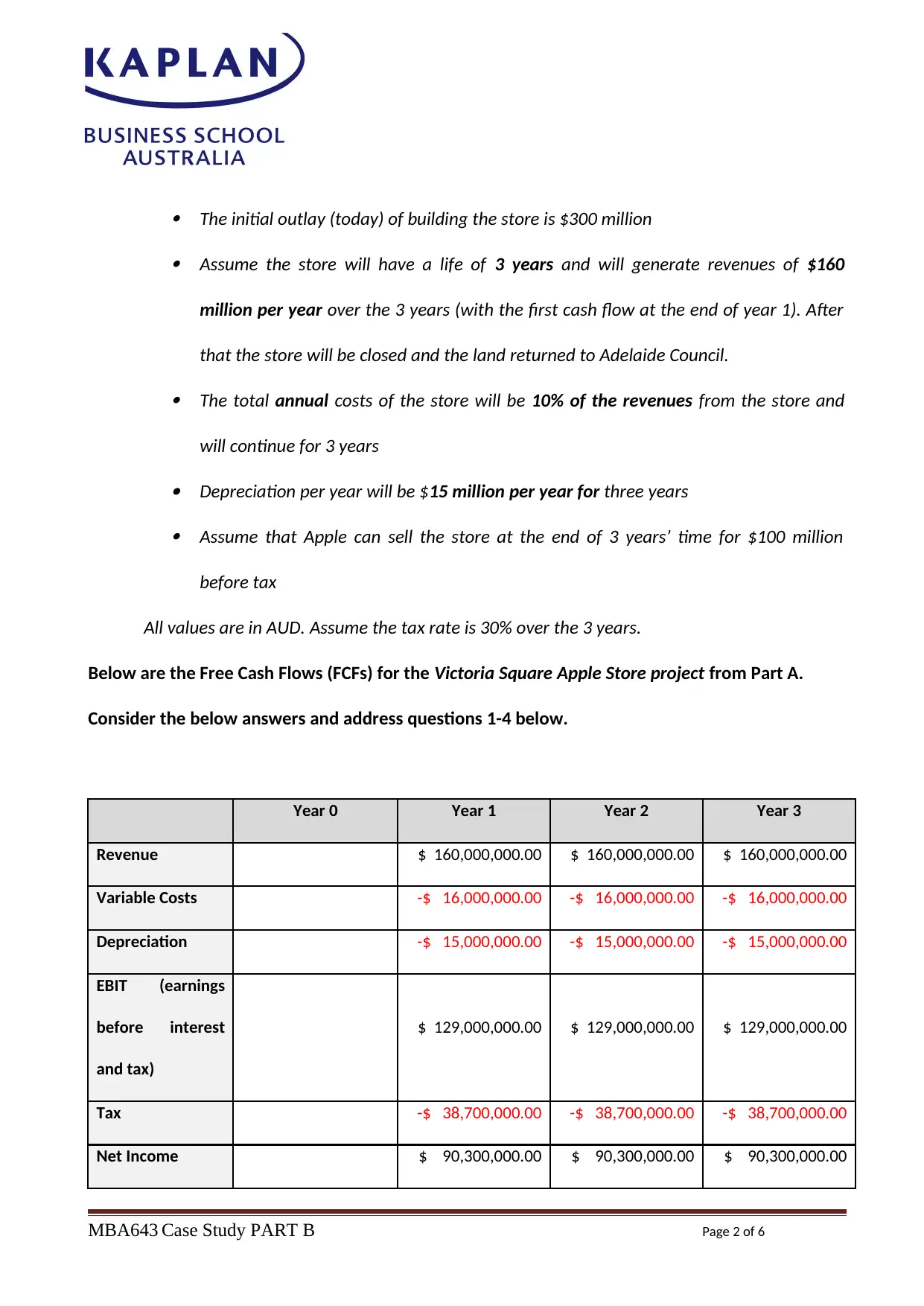
The initial outlay (today) of building the store is $300 million Assume the store will have a life of 3 years and will generate revenues of $160
million per year over the 3 years (with the first cash flow at the end of year 1). After
that the store will be closed and the land returned to Adelaide Council. The total annual costs of the store will be 10% of the revenues from the store and
will continue for 3 years Depreciation per year will be $15 million per year for three years Assume that Apple can sell the store at the end of 3 years’ time for $100 million
before tax
All values are in AUD. Assume the tax rate is 30% over the 3 years.
Below are the Free Cash Flows (FCFs) for the Victoria Square Apple Store project from Part A.
Consider the below answers and address questions 1-4 below.
Year 0 Year 1 Year 2 Year 3
Revenue $ 160,000,000.00 $ 160,000,000.00 $ 160,000,000.00
Variable Costs -$ 16,000,000.00 -$ 16,000,000.00 -$ 16,000,000.00
Depreciation -$ 15,000,000.00 -$ 15,000,000.00 -$ 15,000,000.00
EBIT (earnings
before interest
and tax)
$ 129,000,000.00 $ 129,000,000.00 $ 129,000,000.00
Tax -$ 38,700,000.00 -$ 38,700,000.00 -$ 38,700,000.00
Net Income $ 90,300,000.00 $ 90,300,000.00 $ 90,300,000.00
MBA643 Case Study PART B Page 2 of 6
million per year over the 3 years (with the first cash flow at the end of year 1). After
that the store will be closed and the land returned to Adelaide Council. The total annual costs of the store will be 10% of the revenues from the store and
will continue for 3 years Depreciation per year will be $15 million per year for three years Assume that Apple can sell the store at the end of 3 years’ time for $100 million
before tax
All values are in AUD. Assume the tax rate is 30% over the 3 years.
Below are the Free Cash Flows (FCFs) for the Victoria Square Apple Store project from Part A.
Consider the below answers and address questions 1-4 below.
Year 0 Year 1 Year 2 Year 3
Revenue $ 160,000,000.00 $ 160,000,000.00 $ 160,000,000.00
Variable Costs -$ 16,000,000.00 -$ 16,000,000.00 -$ 16,000,000.00
Depreciation -$ 15,000,000.00 -$ 15,000,000.00 -$ 15,000,000.00
EBIT (earnings
before interest
and tax)
$ 129,000,000.00 $ 129,000,000.00 $ 129,000,000.00
Tax -$ 38,700,000.00 -$ 38,700,000.00 -$ 38,700,000.00
Net Income $ 90,300,000.00 $ 90,300,000.00 $ 90,300,000.00
MBA643 Case Study PART B Page 2 of 6
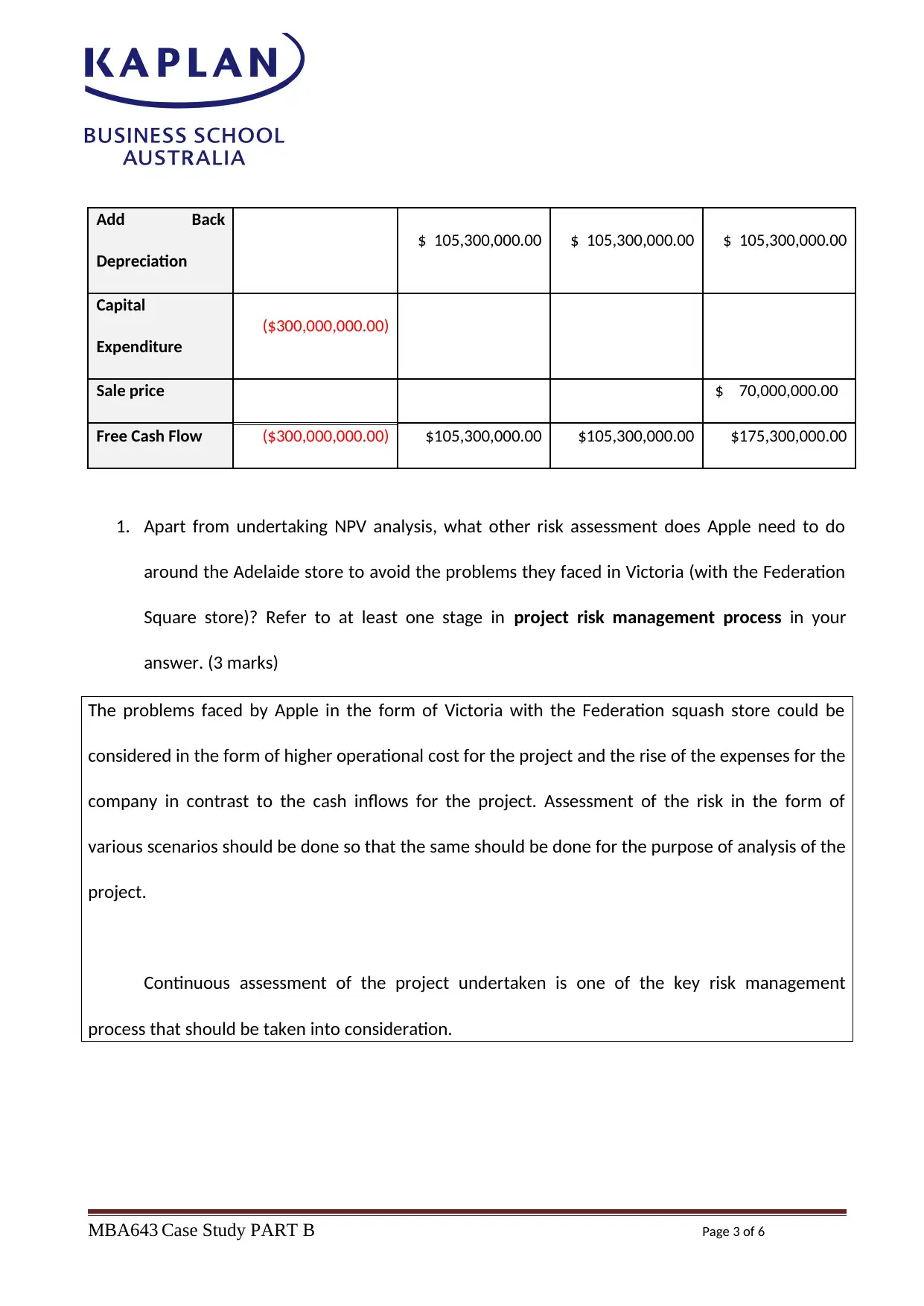
Add Back
Depreciation
$ 105,300,000.00 $ 105,300,000.00 $ 105,300,000.00
Capital
Expenditure
($300,000,000.00)
Sale price $ 70,000,000.00
Free Cash Flow ($300,000,000.00) $105,300,000.00 $105,300,000.00 $175,300,000.00
1. Apart from undertaking NPV analysis, what other risk assessment does Apple need to do
around the Adelaide store to avoid the problems they faced in Victoria (with the Federation
Square store)? Refer to at least one stage in project risk management process in your
answer. (3 marks)
The problems faced by Apple in the form of Victoria with the Federation squash store could be
considered in the form of higher operational cost for the project and the rise of the expenses for the
company in contrast to the cash inflows for the project. Assessment of the risk in the form of
various scenarios should be done so that the same should be done for the purpose of analysis of the
project.
Continuous assessment of the project undertaken is one of the key risk management
process that should be taken into consideration.
MBA643 Case Study PART B Page 3 of 6
Depreciation
$ 105,300,000.00 $ 105,300,000.00 $ 105,300,000.00
Capital
Expenditure
($300,000,000.00)
Sale price $ 70,000,000.00
Free Cash Flow ($300,000,000.00) $105,300,000.00 $105,300,000.00 $175,300,000.00
1. Apart from undertaking NPV analysis, what other risk assessment does Apple need to do
around the Adelaide store to avoid the problems they faced in Victoria (with the Federation
Square store)? Refer to at least one stage in project risk management process in your
answer. (3 marks)
The problems faced by Apple in the form of Victoria with the Federation squash store could be
considered in the form of higher operational cost for the project and the rise of the expenses for the
company in contrast to the cash inflows for the project. Assessment of the risk in the form of
various scenarios should be done so that the same should be done for the purpose of analysis of the
project.
Continuous assessment of the project undertaken is one of the key risk management
process that should be taken into consideration.
MBA643 Case Study PART B Page 3 of 6
⊘ This is a preview!⊘
Do you want full access?
Subscribe today to unlock all pages.

Trusted by 1+ million students worldwide
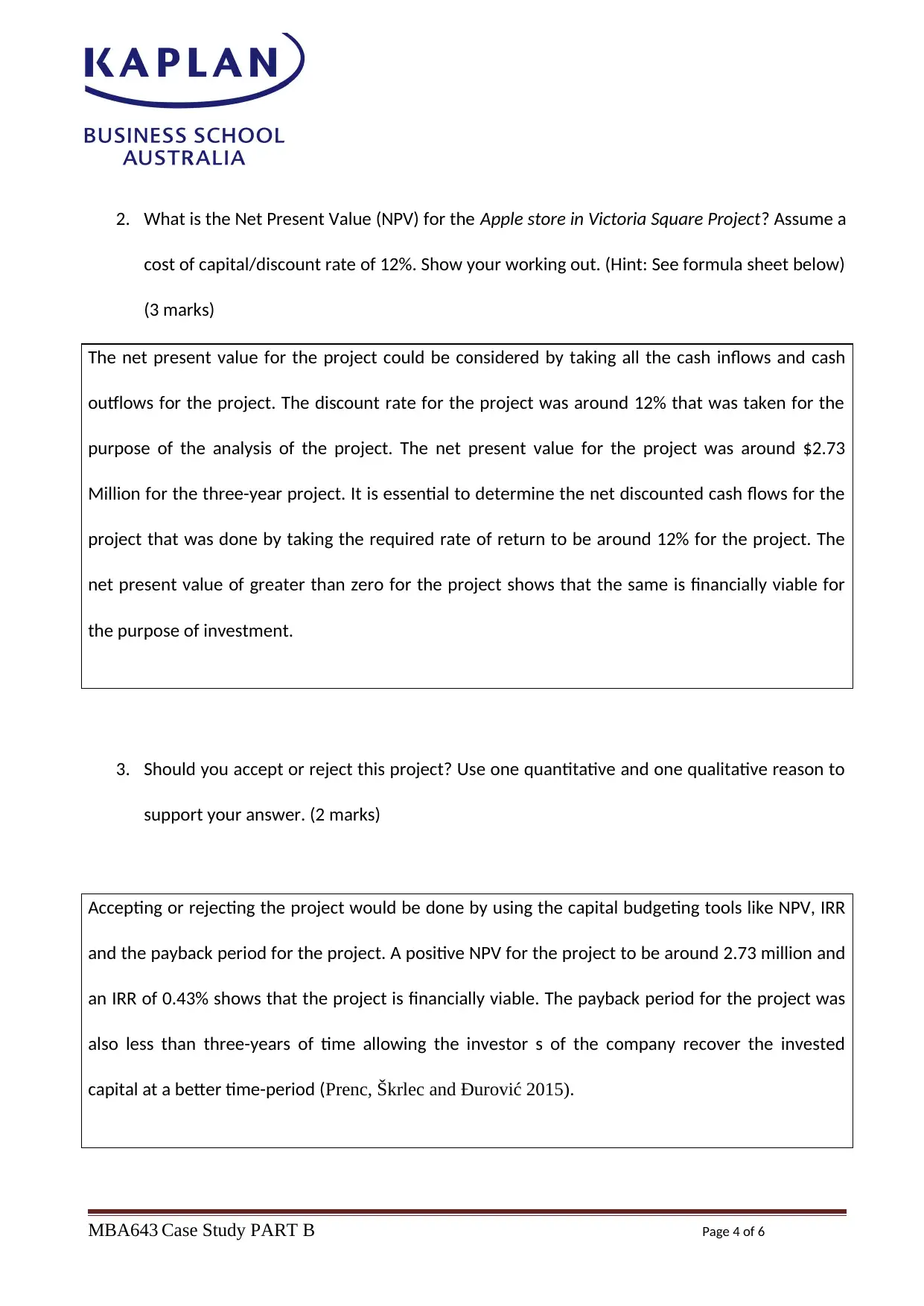
2. What is the Net Present Value (NPV) for the Apple store in Victoria Square Project? Assume a
cost of capital/discount rate of 12%. Show your working out. (Hint: See formula sheet below)
(3 marks)
The net present value for the project could be considered by taking all the cash inflows and cash
outflows for the project. The discount rate for the project was around 12% that was taken for the
purpose of the analysis of the project. The net present value for the project was around $2.73
Million for the three-year project. It is essential to determine the net discounted cash flows for the
project that was done by taking the required rate of return to be around 12% for the project. The
net present value of greater than zero for the project shows that the same is financially viable for
the purpose of investment.
3. Should you accept or reject this project? Use one quantitative and one qualitative reason to
support your answer. (2 marks)
Accepting or rejecting the project would be done by using the capital budgeting tools like NPV, IRR
and the payback period for the project. A positive NPV for the project to be around 2.73 million and
an IRR of 0.43% shows that the project is financially viable. The payback period for the project was
also less than three-years of time allowing the investor s of the company recover the invested
capital at a better time-period (Prenc, Škrlec and Đurović 2015).
MBA643 Case Study PART B Page 4 of 6
cost of capital/discount rate of 12%. Show your working out. (Hint: See formula sheet below)
(3 marks)
The net present value for the project could be considered by taking all the cash inflows and cash
outflows for the project. The discount rate for the project was around 12% that was taken for the
purpose of the analysis of the project. The net present value for the project was around $2.73
Million for the three-year project. It is essential to determine the net discounted cash flows for the
project that was done by taking the required rate of return to be around 12% for the project. The
net present value of greater than zero for the project shows that the same is financially viable for
the purpose of investment.
3. Should you accept or reject this project? Use one quantitative and one qualitative reason to
support your answer. (2 marks)
Accepting or rejecting the project would be done by using the capital budgeting tools like NPV, IRR
and the payback period for the project. A positive NPV for the project to be around 2.73 million and
an IRR of 0.43% shows that the project is financially viable. The payback period for the project was
also less than three-years of time allowing the investor s of the company recover the invested
capital at a better time-period (Prenc, Škrlec and Đurović 2015).
MBA643 Case Study PART B Page 4 of 6
Paraphrase This Document
Need a fresh take? Get an instant paraphrase of this document with our AI Paraphraser
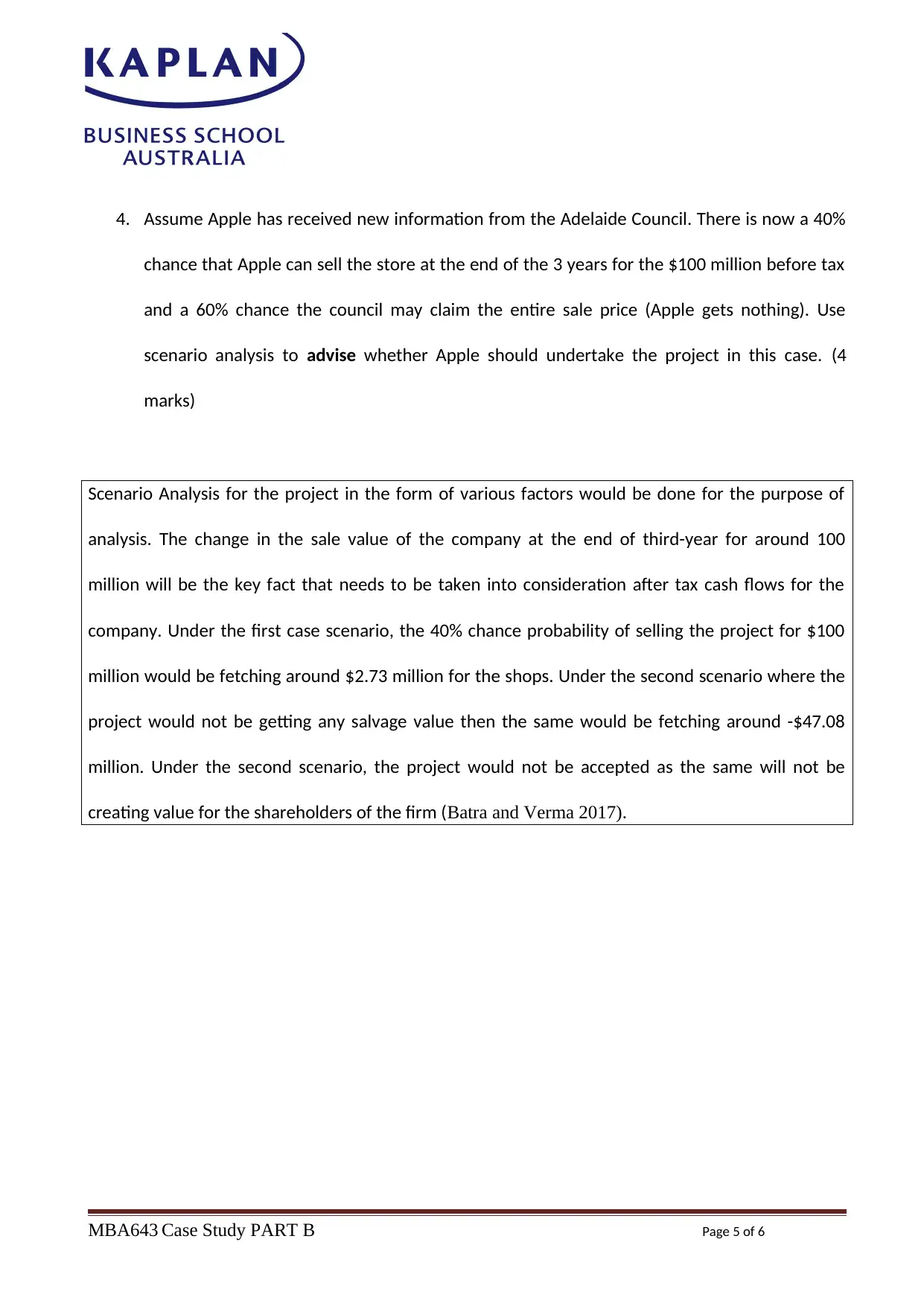
4. Assume Apple has received new information from the Adelaide Council. There is now a 40%
chance that Apple can sell the store at the end of the 3 years for the $100 million before tax
and a 60% chance the council may claim the entire sale price (Apple gets nothing). Use
scenario analysis to advise whether Apple should undertake the project in this case. (4
marks)
Scenario Analysis for the project in the form of various factors would be done for the purpose of
analysis. The change in the sale value of the company at the end of third-year for around 100
million will be the key fact that needs to be taken into consideration after tax cash flows for the
company. Under the first case scenario, the 40% chance probability of selling the project for $100
million would be fetching around $2.73 million for the shops. Under the second scenario where the
project would not be getting any salvage value then the same would be fetching around -$47.08
million. Under the second scenario, the project would not be accepted as the same will not be
creating value for the shareholders of the firm (Batra and Verma 2017).
MBA643 Case Study PART B Page 5 of 6
chance that Apple can sell the store at the end of the 3 years for the $100 million before tax
and a 60% chance the council may claim the entire sale price (Apple gets nothing). Use
scenario analysis to advise whether Apple should undertake the project in this case. (4
marks)
Scenario Analysis for the project in the form of various factors would be done for the purpose of
analysis. The change in the sale value of the company at the end of third-year for around 100
million will be the key fact that needs to be taken into consideration after tax cash flows for the
company. Under the first case scenario, the 40% chance probability of selling the project for $100
million would be fetching around $2.73 million for the shops. Under the second scenario where the
project would not be getting any salvage value then the same would be fetching around -$47.08
million. Under the second scenario, the project would not be accepted as the same will not be
creating value for the shareholders of the firm (Batra and Verma 2017).
MBA643 Case Study PART B Page 5 of 6
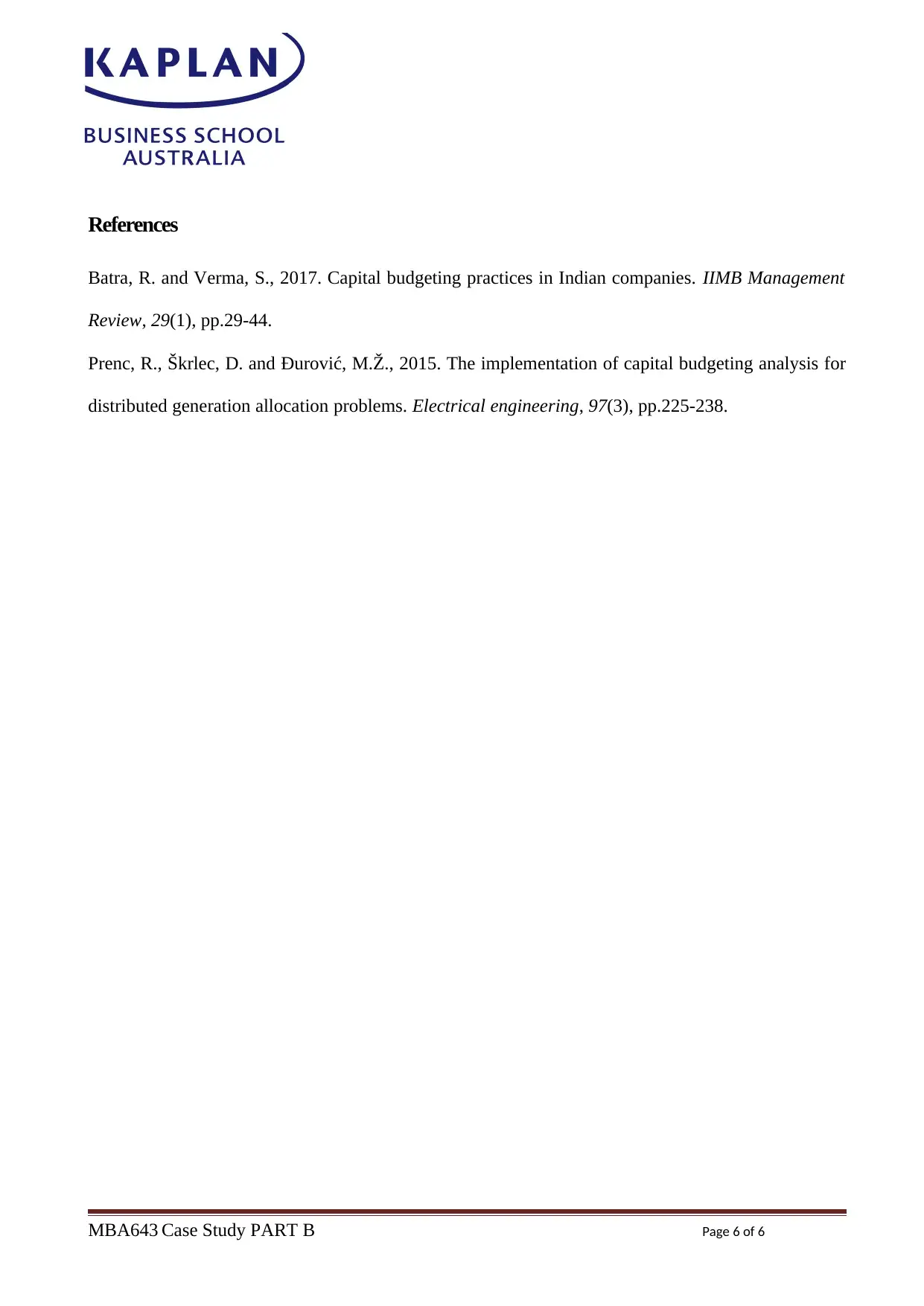
References
Batra, R. and Verma, S., 2017. Capital budgeting practices in Indian companies. IIMB Management
Review, 29(1), pp.29-44.
Prenc, R., Škrlec, D. and Đurović, M.Ž., 2015. The implementation of capital budgeting analysis for
distributed generation allocation problems. Electrical engineering, 97(3), pp.225-238.
MBA643 Case Study PART B Page 6 of 6
Batra, R. and Verma, S., 2017. Capital budgeting practices in Indian companies. IIMB Management
Review, 29(1), pp.29-44.
Prenc, R., Škrlec, D. and Đurović, M.Ž., 2015. The implementation of capital budgeting analysis for
distributed generation allocation problems. Electrical engineering, 97(3), pp.225-238.
MBA643 Case Study PART B Page 6 of 6
⊘ This is a preview!⊘
Do you want full access?
Subscribe today to unlock all pages.

Trusted by 1+ million students worldwide
1 out of 6
Related Documents
Your All-in-One AI-Powered Toolkit for Academic Success.
+13062052269
info@desklib.com
Available 24*7 on WhatsApp / Email
![[object Object]](/_next/static/media/star-bottom.7253800d.svg)
Unlock your academic potential
Copyright © 2020–2025 A2Z Services. All Rights Reserved. Developed and managed by ZUCOL.





